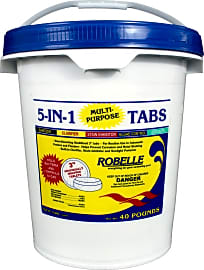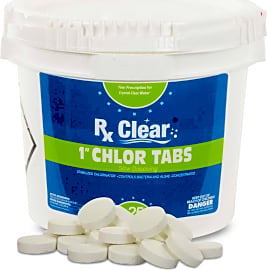The 10 Best Pool Chlorine Tablets

This wiki has been updated 43 times since it was first published in April of 2015. One of the easiest ways to maintain algae-free swimming pool water is to add chlorine. But if you don't want to use messy liquid that can splash on your deck and bleach it, try these convenient tablets instead. They dissolve slowly to ensure even distribution while fighting bacteria and algae constantly, plus they can easily be applied through a feeder, skimmer basket, or a floater. When users buy our independently chosen editorial recommendations, we may earn commissions to help fund the Wiki.
Editor's Notes
September 10, 2020:
Any time you are dealing with chemicals, even when they come in a solid tablet form, you should take the necessary precautions to ensure you stay safe. This includes wearing gloves and eye protection, and, in some cases, a respirator or other kind of mask. It is also important that you never leave these chlorine tablets where curious kids can access them. In addition, you should follow all the manufacturer's recommended usage guidelines, such as putting them in a skimmer basket or floating dispenser, as opposed to simply tossing them into the pool and letting them sink to the bottom, where kids could get to them or they can damage the liner.
When it comes to taking the hassle out of pool maintenance, few are as convenient as HTH Ultimate, Robelle 5-in-1, and Pool Mate 1-1440M All-in-1. All of these include clarifiers, descalers, stain inhibitors, and algaecides, in addition to the expected chlorine. This means that you may not have to put any other chemicals in your pool water, which could also save you a bit of cash in the long run.
Of course, some may want total control over chemical levels in their water. For those people, we recommend tablets that only contain a single active ingredient, trichloro-s-triazinetrione. These include Swim Best Trichlor, Nava 3-Inch, and Rx Clear Chlor, among others.
Those with small pools and hot tubs should generally choose 1-inch tablets, which are the Rx Clear Chlor, Clorox 1-Inch, and Kem-Tek 177. A single one of these small tablets treats roughly 5,000 gallons of water, whereas the 3-inch discs treat 10,000 gallons, if not a bit more, and would be overkill in small bodies of water.
May 07, 2019:
While we might try and avoid chemical exposure in most aspects of our daily lives, if you want clean, safe water for swimming there's no getting around chlorinating the pool, hot tub or spa.
The Robelle 5-in-1 takes the top spot for sanitizing while helping to prevent long term issues like staining and metal corrosion at a price that's not much more than the average pool tablet. The Clorox Xtra Blue provides similar protection with added benefit of water conditioners that some swimmers might prefer, but as these tablets are not as long-lasting, they rank a little further down the list.
We included some one-inch tablet options like the RX Clear and Kem-Tek 177 that may not be practical for the average pool, but ideal for small ones or spas.
Special Honors
Hayward AquaPlus The Hayward AquaPlus is a salt chlorinating system that takes the place of adding chemicals to your water manually. While it can be a costly upfront investment, it could easily save you money over the long run. Plus, and perhaps even more importantly, it can provide a more enjoyable swimming experience because pool goers will find the water to be less irritating to the eyes, have less of a chlorine smell, and be gentler on the hair, skin, and clothes. hayward-pool.com
How Chlorine Keeps You Safe
By the 1920s, pool operators learned about the benefits of adding chlorine to their swimming water to disinfect it and keep it looking cleaner, too.
Chlorine has been a major part of disinfecting water since the 1900s when the water companies started treating their drinking water with it for sanitation purposes. By the 1920s, pool operators learned about the benefits of adding chlorine to their swimming water to disinfect it and keep it looking cleaner, too.
When you add chlorine to water--whether it's in tablet or powder form--it forms a weak acid called hypochlorous acid that's highly effective in killing water-borne bacteria like E. coli and salmonella. It's especially important if you go into public pools since you cannot control which other swimmers are allowed in, and you cannot know what sorts of bacteria they bring along with them.
To put it in simple terms, hypochlorous is a neutrally charged acid, which means it can make contact with the mostly negatively charged bacteria, and break it down. Once inside the bacterium, hypochlorous starts to break down proteins and deteriorate the bacteria. It's important to know that chlorine doesn't work immediately, so follow the instructions about the waiting period on your tablets. It's also important to know that chlorine levels change rapidly, especially when you frequently use your pool or it rains a lot like during the summer, so you have to check levels daily.
Why Chlorine Cannot Work Alone
When you buy a pool, you're likely just thinking about cooling off in the summer and throwing parties, but you don't consider the work that goes into maintaining this big body of water. That's okay--most new pool owners don't know much about pool maintenance, but it is important to keeping the lining of your pool from corroding, which will help keep you and other swimmers safe and healthy. That's where chlorine comes in.
You'll also see corrosion on the handrails and other parts of the swimming pool.
Before adding any chlorine to your pool, you need to test the pH levels to make sure these are correct. It's tempting to just toss your chlorine tablets into the pool and walk away, but if your pH levels are off, the chlorine will not work at its full strength and it will fail to kill all the bacteria and germs. When your pH to chlorine balance is off, you'll notice that your pool water irritates your eyes and skin. You'll also see corrosion on the handrails and other parts of the swimming pool.
Fortunately, there are user-friendly kits that let you test your pH levels, so you can make sure your pool water isn't too acidic, or too base. A safe pH level for a pool is between 7.0 and 7.6. Again, these numbers will appear on the instructions of any pH tester kit you purchase. Achieving results outside of these numbers could make your chlorine dissolve too quickly, or not at all.
The Most Popular Ways To Add Chlorine To Your Pool
If you've been in even a handful of pools, then you'll have noticed that some have little baskets floating around, some have small pods that look like UFOs, and some have a stick-shaped device that resembles an inhaler. These are the three main devices through which pool owners distribute chlorine, but you can add chlorine tablets to any of them.
Water moves quickly over the chlorine tablets in skimmers, disintegrating and dispersing the chlorine evenly.
Let's look at the pros and cons of each device. The small basket is called a floating chlorine dispenser or a floater. Pool experts will tell you that these are the least desirable devices since the little holes in the basket can easily get stuck on corners of the pool, and stay there for days, causing a chlorine buildup in just one area, and a chlorine deficiency in the rest of the pool. The little UFO-looking item is called a chlorine skimmer. Pool experts rank this as the second best way to add chlorine to a pool since it can't get stuck in certain areas. Water moves quickly over the chlorine tablets in skimmers, disintegrating and dispersing the chlorine evenly.
The most dependable, least-hassle tool for adding chlorine to your pool is the automatic chlorinator. Chlorinators let you add several chlorine tablets at once, and then they do the work of sending out calculated amounts of chlorine into your pool, just when your water needs it, so you don't have to think about it. Using an automatic chlorinator does not, however, mean you're off the hook from checking those precious pH levels on a regular basis.















